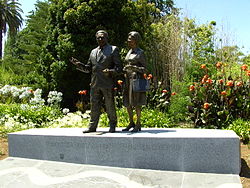The UN Declaration on the Rights of Indigenous Peoples is an aspiration document that is a remedial instrument designed to rectify a history of failings.

Statue of Aboriginal rights campaigner Sir Doug Nicholls, Parliament Gardens, Fitzroy, Victoria
As we discovered above, Indigenous Australians have made use of the existing human rights instruments through the UN to help protect their human rights. But Indigenous Australians have also worked together with indigenous people from around the world to develop their own instrument, one that enshrines indigenous-specific human rights. This is the UN Declaration on the Rights of Indigenous Peoples, developed over the course of 20 years and signed in 2007.
James Anaya, the UN Special Rapporteur on the Rights of Indigenous Peoples, has stated there should not have to be a special instrument to protect the rights of indigenous peoples, because all people have human rights. However, due to the particular historical and contemporary experiences of indigenous peoples there is a need for this special instrument (Anaya, 2009, pp. 58-63).
The UN Declaration on the Rights of Indigenous Peoples is significant to Indigenous Australians for a number of reasons:
- The Declaration took over twenty years of negotiation by indigenous peoples, governments and human rights experts. Many Aboriginal and Torres Strait Islander people were heavily involved.
- The Declaration is significant because indigenous peoples were involved in drafting it. This means the people who held the rights directly participated in the development of the instrument to protect those rights.
- The Declaration is recognition that indigenous peoples are entitled to all human rights as a collective.
- The rights in the Declaration are standards to ensure the survival, dignity and well-being of indigenous peoples. (Human Rights Commission, 2009, p. 6).
A number of countries refused at first to sign the Declaration on the Rights of Indigenous Peoples. Australia was one of those countries, as well as New Zealand, the United States and Canada. In April 2009 the Australian Government changed its position and endorsed the Declaration on the Rights of Indigenous Peoples.
List some of the rights that Aboriginal people have fought for in the 20th century and how they have fought for them.
Here are links to the UN Declaration on Human Rights, and the UN Declaration on the Rights of Indigenous Peoples.
Think about what you have learned thus far, and identify one Human Right and one Indigenous Right that relates to Indigenous Australians and their circumstances.
Summarise the Right and what it relates to/ is intended to overcome.
Key Idea
The UN Declaration on the Rights of Indigenous Peoples is an aspiration document that is a remedial instrument designed to rectify a history of failings.
As we discovered above, Indigenous Australians have made use of the existing human rights instruments through the UN to help protect their human rights. But Indigenous Australians have also worked together with indigenous people from around the world to develop their own instrument, one that enshrines indigenous-specific human rights. This is the UN Declaration on the Rights of Indigenous Peoples, developed over the course of 20 years and signed in 2007.
James Anaya, the UN Special Rapporteur on the Rights of Indigenous Peoples, has stated there should not have to be a special instrument to protect the rights of indigenous peoples, because all people have human rights. However, due to the particular historical and contemporary experiences of indigenous peoples there is a need for this special instrument (Anaya, 2009, pp. 58-63).
The UN Declaration on the Rights of Indigenous Peoples is significant to Indigenous Australians for a number of reasons:
A number of countries refused at first to sign the Declaration on the Rights of Indigenous Peoples. Australia was one of those countries, as well as New Zealand, the United States and Canada. In April 2009 the Australian Government changed its position and endorsed the Declaration on the Rights of Indigenous Peoples.
Learning Activity
List some of the rights that Aboriginal people have fought for in the 20th century and how they have fought for them.
Here are links to the UN Declaration on Human Rights, and the UN Declaration on the Rights of Indigenous Peoples.
Think about what you have learned thus far, and identify one Human Right and one Indigenous Right that relates to Indigenous Australians and their circumstances.
Summarise the Right and what it relates to/ is intended to overcome.
Content is available under the
Creative Commons Attribution Share Alike License.
Privacy Policy | Authors